 Cyber Access
Cyber Access
Cyber Access is an app that uses Bluetooth technology to request access to CyberLock products.
Cyber Access is available in both Android and iOS versions available from the Google Play Store
and the Apple App Store.
Cyber Access for Android requires Android OS 10 or higher.
Cyber Access for iOS requires iOS 13 or higher.
Cyber Access works with these CyberLock products:
- FlashReader and FlashReader Keypads for granting access to doors
- Granting access to CyberLock Blue
- Granting access to FlashBox via Bluetooth
| Search for Cyber Access in Google Play or the Apple App Store and install
the app.
Then find a person in the list of people and click on the record. Select 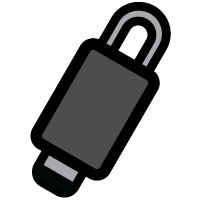 Cyber Access
from the menu and then Cyber Access
from the menu and then  Send Cyber Access.
Send Cyber Access.
|
 |
|
| The person will receive an email or text with a link. Clicking on the link will connect the app with the person and register it with the account. If the Cyber Access app has not been installed, it will take them to the Play Store or App Store to install the app. After installing the app, the user may click the link again. |
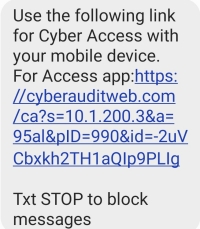
|
|
| Android | iOS |
|
Once installed, Cyber Access will ask for permission to use Bluetooth and Location
on the device. Enabling Notifications is also recommended. Bluetooth is required because that is the way the phone or tablet connects to CyberLock accessible devices like a Flex System FlashReader or FlashReader Keypad. Granting permission to location enables Cyber Access to scan for accessible devices and notify the user when they are in range. Cyber Access cannot find and connect to any accessible device without granting permission to location. Allowing location access always or at all times allows Cyber Access to scan for devices when the app is not being used and notify the user when they are in proximity. This can happen even when the Cyber Access app is closed. |
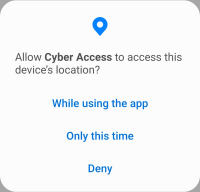 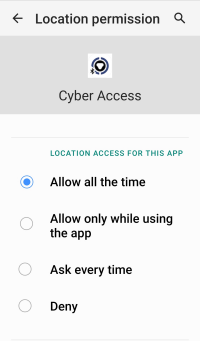
|
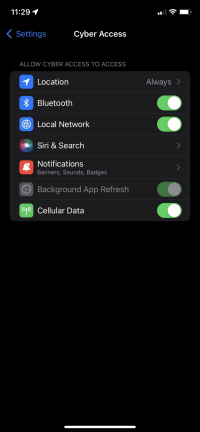
|
| Android 12 added an additional permission to enable Bluetooth on the device. Enable Nearby Devices when prompted. | The Android operating system may restrict Cyber Access from scanning for doors while Cyber Access is not in the foreground. This could prevent detecting doors and sending a notification or auto-opening. To avoid this, allow Cyber Access to have Unrestricted battery use while in the background. |
iOS requires no additional location settings for Bluetooth. The beacon technology provided by iOS provides an efficient location monitor and requires no special battery settings. |
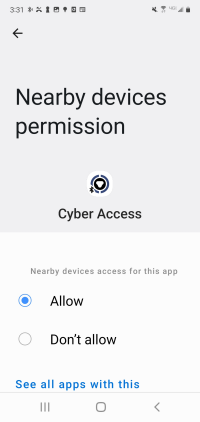
|
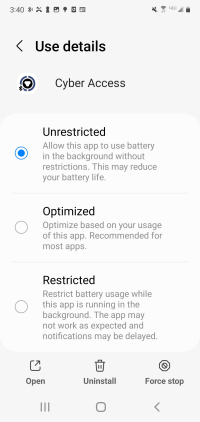
|
|
| Enable notifications from the Settings menu. |
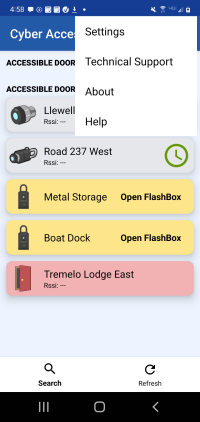
|
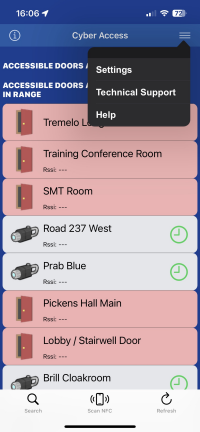
|
|
Send notification when a door is in range - A notification can let the user know
when a reader for an accessible device is nearby. It can even notify them when the app
is in the background or the phone or tablet is asleep. When the notification appears,
the user may tap it to send an open request to the reader. This may be preferable
to finding and opening the app each time they wish to open a door.
The notification happens when Cyber Access sees the reader transition from “out-of-range” to “in-range”. |
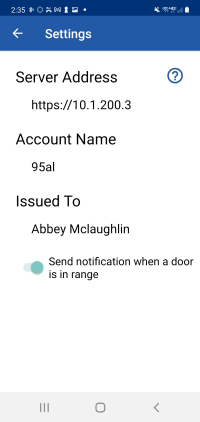
|
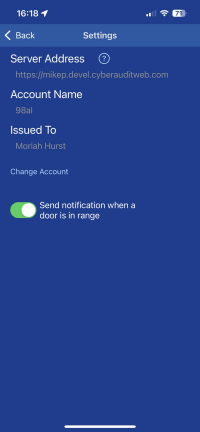
|
|
Clicking the settings icon,
Automatically Open Door – When this option is shown, Cyber Access can automatically send a request to open the door in addition to sending a notification. Sensitivity determines when the phone or tablet is “in-range” of an accessible device based on the Rssi level. In general, the closer the phone or tablet is to the reader, the lower (stronger) the Rssi. But there are other things that can affect Rssi. Objects between the phone or tablet and the reader can block the signal. So can RF radiators like electrical devices. The phone user can adjust sensitivity so notifications happen when they’re in good proximity to the reader. |
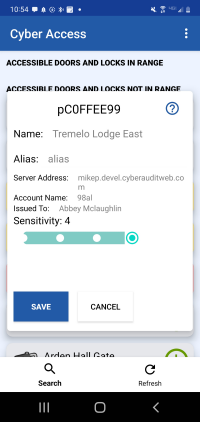
|
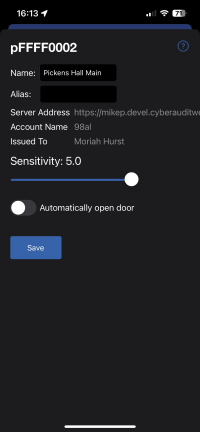
|
Using Cyber Access with Bluetooth
| Android | iOS |
|
Once connected, Cyber Access will load the list of accessible doors and CyberLock Blues
from the server and show them on a list. Doors and locks in range of Cyber Access will be
shown at the top of the list. Wake up the Bluetooth radio on a CyberLock Blue to start its beacon broadcast and cause it to show in range. |
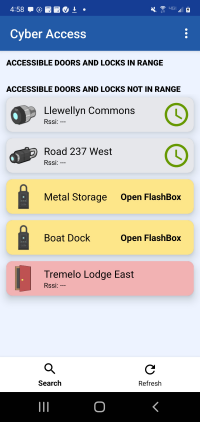
|
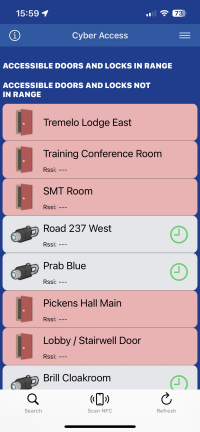
|
|
Tapping on an in-range door or lock will tell Cyber Access to connect to that device and open it.
If a PIN is required to open a door, the user will be notified on the app and at the reader. FlashBox will not appear in range. Instead press the button on the FlashBox to wake its bluetooth radio, hold the mobile device against the FlashBox, then tap on the FlashBox in Cyber Access. 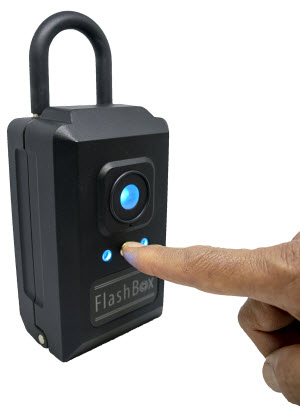
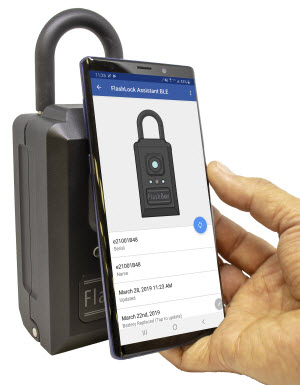
|
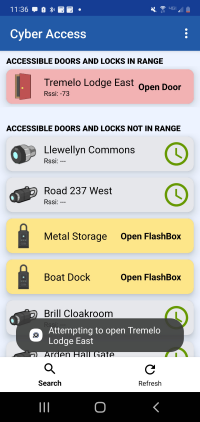
|
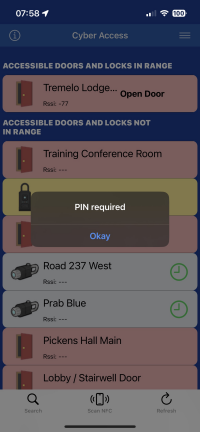
|
Bluetooth Background Behavior
When the app is in the foreground, its ability to detect a FlashReader for a door is most efficient because it is getting priority from the operating system. Once a door is in-range, the user may tap on the in-range door to open it. When the app is in the foreground, the door will normally open within two seconds. This is the time required to establish a Bluetooth connection with the FlashReader.
But commonly the owner of the mobile device will use it with multiple apps and will prefer not to bring the Cyber Access app to the foreground to open a door each time. As such, features that send a notification or automatically open a door are designed to run in the background. Once and in-range FlashReader is detected, it may take up to five seconds to connect and open the door.
The behavior of Cyber Access on each mobile operating system is outlined below.
| Android | iOS | |
|
|
||
| When the app is closed or has not been started | There will be no notifications or automatic opening of doors. The app must be run to scan for doors with FlashReaders (beacons). | Cyber Access uses a change in location to temporarily wake up the app and scan for doors with FlashReaders (beacons). The location is updated by iOS when the device moves to another location. |
|
|
||
| When the app is running in the background | Cyber Access scans continuously for FlashReaders. If notifications are enabled, a "Scanning for Doors" notification is sent. When a FlashReader for a door comes in-range, notifications are allowed, and the door is not set to automatically open, Cyber Access will send a notification to tap. The notification may not be visible if the screen is off. If "automatically open" is enabled, Cyber Access will attempt to connect to the door and send a request to open it. |
Cyber Access scans for FlashReaders when it detects a change in location from iOS.
When a FlashReader for a door comes in-range: If notifications are permitted but the door is not set to automatically open, Cyber Access will send a notification to tap. Tapping the notification opens the Cyber Access app and opens the door. If "automatically open" is enabled for the door, Cyber Access will attempt to connect to the door and send a request to open it. |
Using Cyber Access with NFC
| Android | iOS | |||||||
|
|
||||||||
| NFC support | Varies by brand and model | iPhone XS and later with iOS 11 or later will support reading NFC tags | ||||||
|
|
||||||||
| NFC mode |
Host Card Emulation and Tag Emulation * Some Android devices such as Google Pixel do not reliably work with the FlashReader |
Tag Emulation mode only | ||||||
|
|
||||||||
| Behavior when Cyber Access is not installed |
When NFC is enabled, android devices behave differently depending on the mode of the reader: Tag Emulation mode - When the CyberLock device is detected, it will go to the Google Play Store to download Cyber Access HCE mode - The FlashReader will respond to the phone as an unknown RFID card. |
When an iOS device detects the CyberLock NFC tag, it displays this notification: . Tapping the notification will go to the Apple App Store to download the Cyber Access app. |
||||||
|
|
||||||||
| Behavior when Cyber Access is installed and active with an account | When the Android phone is awake and logged in, it will interact with the CyberLock device. If the user has access permissions, Cyber Access will attempt to open the device. If the user has access permissions and no PIN is required, access is granted without further user input. |
iOS devices must be told to scan for an NFC device to interact with. When the iPhone is awake, and
it discovers a CyberLock NFC tag, it will show this notification: . |
||||||
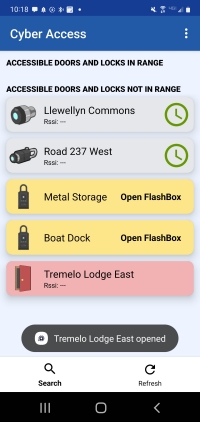
|
Tapping the notification will open Cyber Access with the "Ready to Scan" dialog. | |||||||
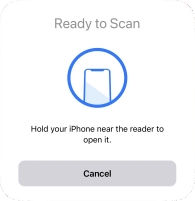
|
||||||||
| At this point when the iPhone detects the tag again, it will attempt to open the CyberLock device. | ||||||||
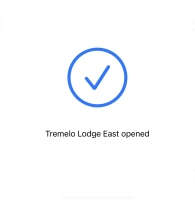
|
||||||||
|
|
||||||||
| Using NFC to open a door |
|
|
||||||
| When the FlashReader is successfully communicating with a phone it will emit a chirping sound. |
|
|||||||


